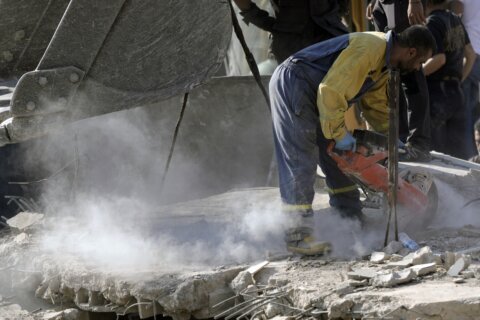The last year of high mortgage rates has affected the Washington, D.C., housing market just as it has many others — but to a seemingly lesser degree.
While prices are down in the Washington-Arlington-Alexandria metropolitan statistical area (MSA), they’ve only decreased a small amount and are now climbing back upward. Housing supply remains incredibly low, and thanks to improving consumer sentiment, demand is picking up, too.
As Cameron Nikkhah, a local real estate broker with Realty ONE Group Capital, says, “It’s still bustling, but the pace has calmed down a bit from the madness of last year.”
Can we expect that trend to continue as 2023 goes on, or will the D.C. market pick up speed? Here’s what data from the U.S. News Housing Market Index tells us about the market over the past year, its current state and what to expect in the months to come.
[Read: Your Guide to the Housing Market.]
How the Washington, D.C., Housing Market Changed in 2022
Permits for single-family construction took a steep dive in 2022, falling from a peak of 1,495 in March to just 600 come December, a 60% drop. Things have turned a corner since then, though.
From February through April, 2,869 single-family permits were approved in the Washington, D.C., MSA. While that’s down 24% from the 3,766 approved in the same period a year prior, it’s a notable improvement over the back half of 2022. According to our forecast, this trend should hold steady before permits fall slightly in early fall.
Multifamily permits have taken an almost opposite path. Those rose steadily across most of 2022, jumping from a low of 1,115 in January to 2,000 at their peak in October. Since the end of the year, though, things have changed dramatically.
In December, nearly 2,000 multifamily permits were approved in the city. By April, it was just 1,241.
Still, if we compare things to a year ago, conditions have actually improved slightly. From February to April, 4,094 multifamily permits were approved in the MSA. For the same period in 2022, it was 3,699 — marking an increase of about 11%. That improvement may be limited, though. Our forecast shows multifamily permits will likely fall further as we get closer to fall.
[READ: HOA, POA, COA: What’s the Difference in These Homeowner Associations?]
Washington, D.C., Housing Supply and Demand
As is the case in most of the country, one of D.C.’s biggest challenges is its lack of housing supply. While inventory has improved slightly over the last year (an increase of nearly half a month), the MSA has a mere 1.8-month supply of homes for sale. That’s less than the nation’s 2.1-month supply and far below the 6.5 months generally considered a balanced market, where supply and demand are even.
Part of this low supply comes down to higher mortgage rates. And until those reverse course, supply will likely remain low for some time.
“Homeowners who snagged those low rates in the past aren’t exactly jumping at the chance to sell their homes,” Nikkhah says. “Unless they’re shifting jobs or downsizing, expect them to stay put. This means the supply of homes up for grabs isn’t going to balloon overnight.”
Higher mortgage rates are also pushing buyers out of the market. According to the Mortgage Bankers Association, applications to purchase a home are down 32% over the year.
For the week ending June 16, the Mortgage Bankers Association’s seasonally adjusted Purchase Index increased by 0.5% compared with the prior week. On an unadjusted basis, the Index decreased 1% compared with the previous week.
Since many of those would-be buyers get forced into renting, the D.C. MSA’s rental vacancy rate has dropped to 5.5%, according to the Census Bureau. That’s a 0.2% dip compared to last year and nearly a full percent lower than the nation’s average vacancy rate.
Where things go from here will largely depend on mortgage rates and how they impact consumer sentiment. Currently, overall consumer sentiment is down 1.7% compared to a year ago, according to a recent survey from the University of Michigan — though it has been improving in recent months from a low of 50 in June 2022.
Median Home Price in Washington, D.C.
The median home price in the Washington, D.C., MSA sits at $545,000, according to Redfin. That’s down almost a full percent from a year ago but a notable jump from January, when the median price was just $475,000.
“Lower interest rates on the horizon might bring even more buyers into the game, so brace for those prices to keep on rising,” Nikkhah says. “As long as we’ve got more buyers than homes available, prices are likely to keep climbing.”
D.C.’s prices are also much higher than the national median, which hovered just above $400,000 as of April.
Movements like Arlington’s “Missing Middle Housing” are aiming to tackle these sky-high prices by encouraging denser housing options, like duplexes, triplexes and townhomes. Builders like Drees Homes are also helping to contribute more units to the region.
“Condominiums and attached housing are the counties’ solution to address affordability,” says Alicia Skoug, president of the Washington, D.C. division of Drees Homes. “We are now building condos in Stafford and Prince William and will soon offer opportunities in Loudoun and Fairfax.”
Rents have jumped almost 5% in the D.C. metro over the last year, according to the Zillow Observed Rent Index. The average rent currently clocks in at $2,264 per month — over $200 more than the nation’s average.
[Read: The Rise of Built-for-Rent]
Unemployment Trends in Washington, D.C.
The job market in the D.C. metro is going strong. Employment is up, with a gain of more than 61,000 jobs over the last year, and unemployment has fallen to just 2.3%. That’s a 0.7% dip compared to last year and below the nation’s 3.4% unemployment rate.
This strong job market should keep demand high for the area’s housing — especially as an election year approaches.
As Nikkhah explains, “The federal government’s a major player in D.C.’s job market, creating lots of opportunities for contractors and consultants.”
Despite the strong job market, foreclosures have jumped at the state level over the last year, with a 0.4% uptick, according to Black Knight. The current foreclosure rate is 0.7% — well above the nation’s 0.44% rate.
Builder Confidence in Washington, D.C., Starts to Improve
Builder sentiment fell significantly last year, bottoming out at a 35 score out of 100. Things have started to improve since then, though, with sentiment sitting at a 55 as of May, according to the National Association of Home Builders/Wells Fargo Housing Market Index.
The turnaround may have something to do with construction costs, which have also reversed course nationally in recent months. While they’re technically up 3.5% over the year, costs have eased quite a bit since their November 2022 peak, according to the Census Bureau.
Nonresidential construction has also declined in the region, falling more than 8% over the last year, according to the Architecture Billings Index. Total architectural billings are now below national numbers.
Washington, D.C. Real Estate Market: Predictions
With consumer and builder sentiment improving and steady demand from a booming job market (plus an election on the way), it’s no wonder our index shows the Washington, D.C., metro as the ninth-strongest in the nation.
And thanks to ultra-low supply — plus our forecasts showing declines in both single-family and multi-family permits on the horizon — it should remain that way for the foreseeable future.
“Despite a few speed bumps like fluctuating interest rates and a smaller selection of homes, the D.C. market is holding strong,” Nikkhah says. “Looking forward, we’re expecting the D.C. housing market to stay lively.”
More from U.S. News
The Hottest Housing Markets in the U.S.
Housing Market Predictions for the Next 5 Years Promise Lots of Surprises
When Will the Housing Market Crash?
D.C. Housing Market Forecast originally appeared on usnews.com







